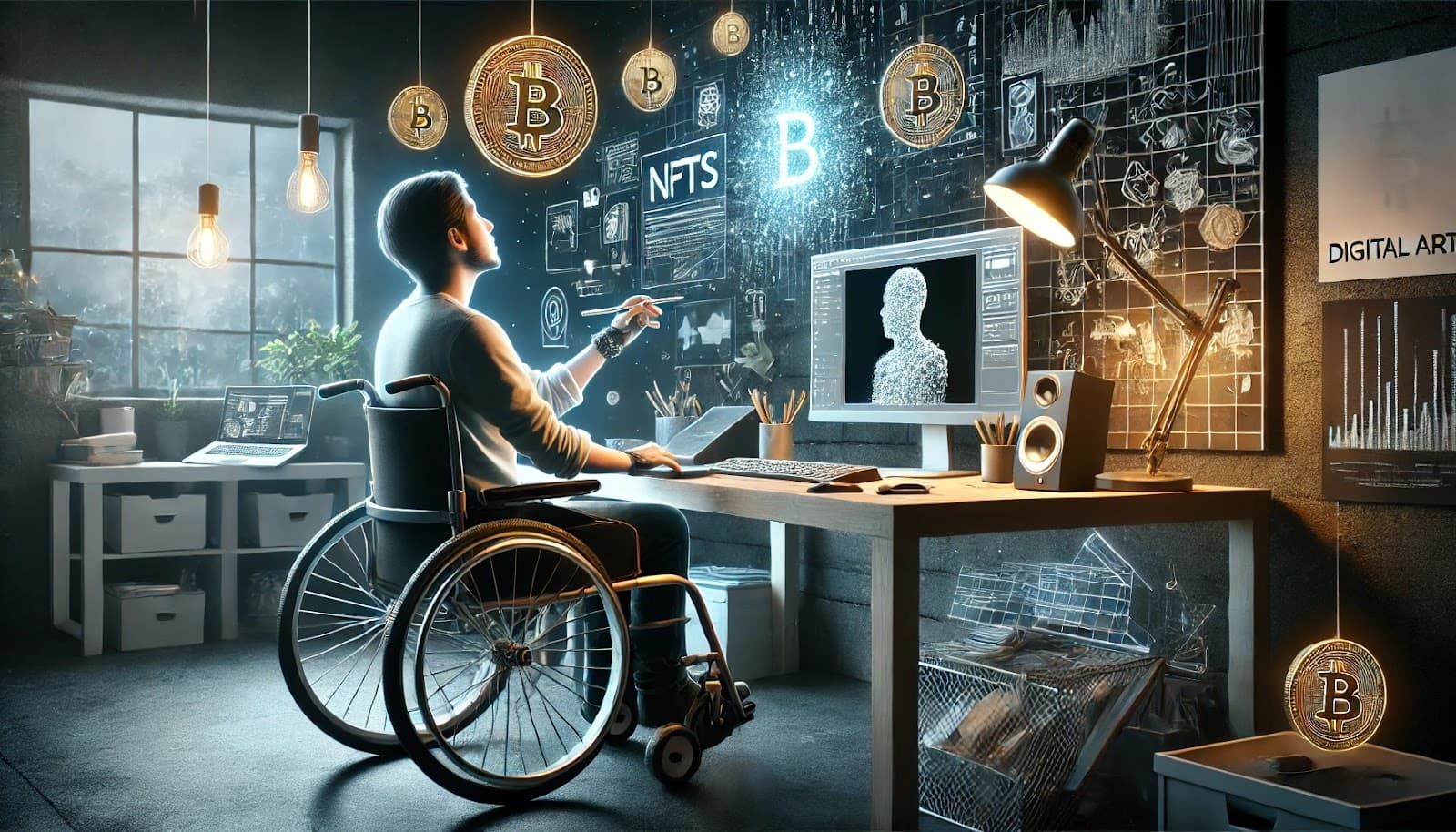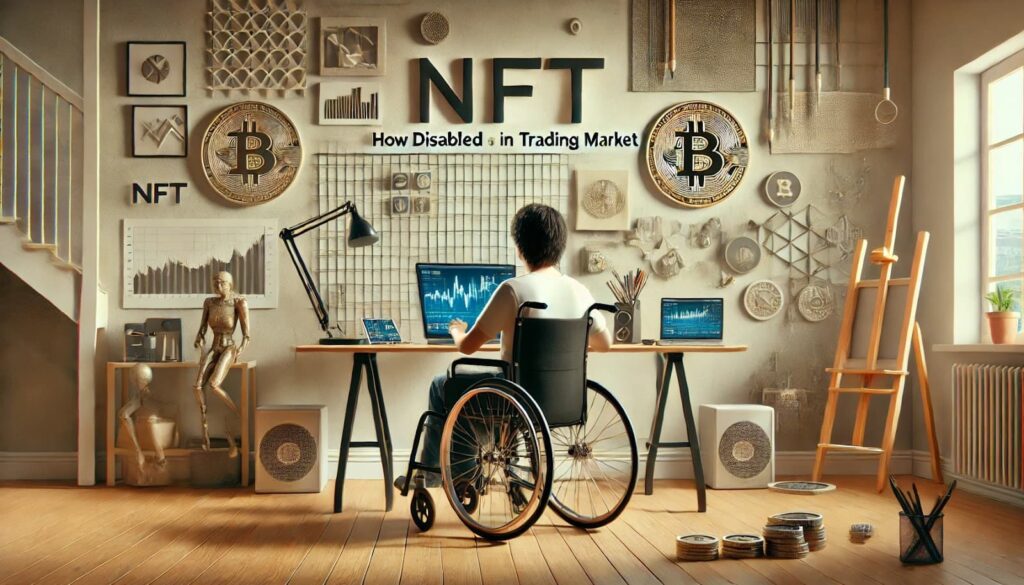
The Potential of Digital Art and NFTs for Disabled Artists in the Trading Market
The rise of digital art and NFTs (Non-Fungible Tokens) has revolutionized the art market, opening new doors for artists from diverse backgrounds. For disabled artists, this innovation is especially impactful, offering unprecedented opportunities to overcome the barriers they traditionally face in the physical art world. Disabilities can often hinder access to galleries, exhibitions, or even basic mobility within the art scene, but digital platforms break down these walls. NFTs allow artists to create, sell, and display their work online, reaching a global audience without the need to travel or face physical limitations. Moreover, the ownership of digital art through NFTs ensures that disabled creators can maintain control over their work and its sales, offering a new level of economic empowerment. The growing interest in digital art platforms can create a level playing field where disabled artists can thrive, promoting inclusivity and accessibility across the art world.
As NFTs continue to gain traction, platforms like the Exness web terminal play a vital role in democratizing access to digital trading. Artists can use such tools not only to trade their own work but also to explore and engage with the wider market, navigating the complexities of NFT sales and blockchain technology. These tools make it easier for disabled artists to manage and track their NFT transactions, allowing them to focus on their craft rather than becoming overwhelmed by technical barriers. The integration of these technologies in the art world can provide disabled artists with greater financial independence and recognition. By removing physical constraints and offering accessible digital solutions, NFTs hold the potential to transform how disabled artists participate in the art market, bringing both creative and financial freedom to a previously underserved community.
Understanding Digital Art and NFTs
Digital art and NFTs (Non-Fungible Tokens) are two interconnected concepts that have gained significant attention in recent years, especially in the realms of art, technology, and finance. Here’s an overview of each and how they connect:
Digital Art
Digital art refers to any artwork created using digital technology, often on a computer or tablet. The medium can include:
- Digital illustrations and paintings created with software like Adobe Photoshop, Procreate, or Illustrator.
- 3D modeling and animation, such as works created in Blender or Autodesk Maya.
- Photography, especially when digitally edited or manipulated.
- Generative art, which uses algorithms or artificial intelligence to create unique pieces.
Digital art is versatile and can take many forms, including still images, animations, videos, and even interactive installations. Artists use it as a means to explore new techniques, express creativity, and reach global audiences.
NFTs (Non-Fungible Tokens)
An NFT is a unique digital asset representing ownership or proof of authenticity of a specific item, typically using blockchain technology. While NFTs are often associated with digital art, they can represent ownership of any kind of digital asset (e.g., music, videos, tweets, etc.). The key features of NFTs include:
- Uniqueness: NFTs are “non-fungible,” meaning each token is distinct and cannot be exchanged for another on a one-to-one basis. This sets them apart from fungible assets like cryptocurrencies (e.g., Bitcoin or Ethereum), where each unit is identical.
- Ownership and Provenance: NFTs use blockchain technology, which provides a decentralized ledger that records the ownership history of the asset. This ensures that buyers can trace the authenticity of a digital item, which is essential for collecting art.
- Smart Contracts: NFTs are built on smart contracts, which are self-executing contracts with the terms directly written into code. This allows for automated processes such as transferring ownership and enforcing royalties.
- Marketplace and Trading: NFTs can be bought, sold, and traded on various platforms such as OpenSea, Rarible, and Foundation. These marketplaces allow artists to monetize their digital work by selling exclusive ownership rights.
How Disabled Artists Work in the Trading Market
For disabled artists, the trading market, particularly in the realm of digital art and NFTs, offers unique opportunities that can help overcome the challenges they face in traditional art spaces. Traditional galleries and physical art markets often present significant barriers for disabled artists, such as accessibility issues, limited mobility, and the need for physical presence to showcase and sell artwork. Digital art and NFTs eliminate many of these obstacles, allowing disabled creators to focus on their craft and reach a wider audience without having to leave their homes. By selling their work on NFT platforms, these artists can bypass traditional intermediaries like galleries, which often take a significant commission, and instead retain more control over their sales and the distribution of their work.
In the NFT space, disabled artists are not only able to create and sell art but also engage with a global market of buyers and collectors. They can use online platforms to display their digital creations, interact with potential buyers, and even participate in virtual exhibitions or auctions. Platforms like OpenSea, Rarible, and Foundation allow artists to tokenize their work and list it for sale as NFTs. This system creates a direct and accessible way to monetize digital art, offering new income streams and financial independence. Additionally, the blockchain technology behind NFTs ensures that artists receive royalties on secondary sales, creating a sustainable revenue model. For disabled artists, these tools offer not only financial gain but also empowerment, as they can fully manage their own art market presence and avoid the physical and logistical barriers of traditional trade environments.

How NFTs and Digital Art Create Opportunities for Disabled Artists
NFTs (Non-Fungible Tokens) and digital art have opened up significant opportunities for disabled artists, providing them with new platforms for creative expression, financial independence, and exposure. Here’s how they contribute to empowering disabled artists:
Accessibility to a Global Market
NFTs allow artists to sell their works to a global audience without the need for physical galleries or intermediaries. This is particularly important for disabled artists who may face mobility challenges or other physical limitations that make traditional gallery exhibitions difficult or inaccessible. With NFTs, artists can showcase and sell their digital artwork from anywhere, creating a level playing field.
Creative Freedom
Digital art, including NFTs, removes the barriers imposed by physical media. Artists with physical disabilities may find it easier to create art digitally using software and tools that are adaptable to their needs. For example, using voice commands, adaptive devices, or digital tools designed for accessibility, disabled artists can produce and modify art with fewer physical constraints.
Financial Independence
NFTs provide a new revenue stream for digital artists. Artists can sell their works directly to buyers, often receiving a more significant portion of the proceeds compared to traditional art sales. Furthermore, NFTs can be programmed with royalties, ensuring that artists receive ongoing compensation every time their artwork is resold. This can offer disabled artists financial stability and independence, particularly if they are unable to work in traditional employment settings.
Building a Community
NFTs are often bought, sold, and traded within specific communities, many of which are passionate about supporting diverse and underrepresented artists. Disabled artists can connect with like-minded creators and buyers, creating a network of support that might not have existed in traditional art spaces. The decentralized nature of NFTs allows artists to bypass traditional gatekeepers in the art world and directly engage with their audience.
Digital Tools for Enhanced Creativity
For disabled artists, the rise of digital tools designed to enhance creativity is a significant advantage. Software like Adobe Creative Cloud, Procreate, and others offer various assistive technologies, such as screen readers, customizable interfaces, and voice-activated tools. These tools enable disabled artists to experiment and create art in ways that might be difficult or impossible using traditional media.
Increased Exposure and Recognition
NFTs and digital art are at the forefront of the art world’s attention. As these technologies become more mainstream, disabled artists are gaining recognition for their work. With platforms such as OpenSea, Rarible, and Foundation, disabled artists have opportunities to exhibit their creations in a space where collectors, investors, and other artists are eager to discover new talent.
The Future of Digital Art and NFTs for Disabled Artists
The future of digital art and NFTs (Non-Fungible Tokens) for disabled artists holds significant promise. With the rise of digital technologies and decentralized platforms, disabled artists have new opportunities to showcase their talents, reach a global audience, and gain recognition in ways that were previously inaccessible. Here are several key aspects that can shape this future:
Increased Accessibility and Inclusivity
- Digital platforms allow artists with disabilities to create, display, and sell art from the comfort of their homes, regardless of physical limitations. Artists who may struggle with mobility, vision, or other disabilities can participate fully in the digital art space without barriers to access.
- Assistive technology: Tools like voice recognition software, screen readers, adaptive controllers, and software with high customization make it easier for disabled artists to create art without physical restrictions. These technologies help overcome barriers, making art creation more inclusive.
Global Exposure and Market Reach
- NFT marketplaces like OpenSea, Rarible, and Foundation allow disabled artists to share their work with a global audience, creating new income streams and exposure that might not be available in traditional art markets.
- Through NFTs, artists can control their intellectual property rights, ensuring that their work is properly recognized and compensated whenever it is resold, a feature that benefits marginalized and underrepresented artists.
Ownership and Royalty Systems
- One of the most exciting aspects of NFTs for disabled artists is the ability to retain control over their art and automatically receive royalties whenever their work is resold on secondary markets. This model can ensure a continuous income stream for artists, which is especially valuable for disabled individuals who may face employment challenges in traditional sectors.
- NFTs also enable the creation of artistic communities where disabled artists can network, collaborate, and share their work with others in similar circumstances. These communities provide mutual support and help foster a sense of belonging.
Artistic Expression and New Mediums
- Digital art is often more malleable and diverse than traditional forms, enabling disabled artists to explore different mediums without physical constraints. The use of 3D modeling, virtual reality (VR), and augmented reality (AR) in NFTs opens up new avenues for artistic expression, allowing for innovative works that can be experienced in immersive ways.
- The use of AI-generated art is also an emerging trend, where artists can collaborate with artificial intelligence to create new pieces, making it easier to produce intricate artworks without needing advanced physical skills.
Recognition and Empowerment
- NFTs and digital art have the potential to disrupt the art world by giving marginalized artists a chance to gain recognition, regardless of their physical or cognitive limitations. In a traditional art world that has often overlooked disabled artists, the digital space can offer a level playing field where anyone can rise to prominence based on their talent.
- Platforms and initiatives dedicated to showcasing diverse artists are gaining traction, and as the market for digital art grows, there’s more room for disabled artists to thrive in a space where they can be celebrated for their uniqueness and creativity.
Conclusion
The potential of digital art and NFTs for disabled artists in the trading market is both transformative and empowering. By leveraging digital platforms, disabled artists can bypass the physical limitations of traditional art spaces, creating and showcasing their work in a more accessible, inclusive environment. NFTs provide a unique opportunity for these artists to retain control over their creations, ensuring the authenticity and ownership of their work while also offering new revenue streams through direct sales and royalties. As the NFT market continues to grow, it presents a sustainable path for disabled artists to gain visibility, financial independence, and recognition on a global scale. With the ongoing development of accessible technologies and more inclusive platforms, the future of digital art and NFTs promises to reshape the art world, offering a more equitable and diverse space for disabled creators to thrive.